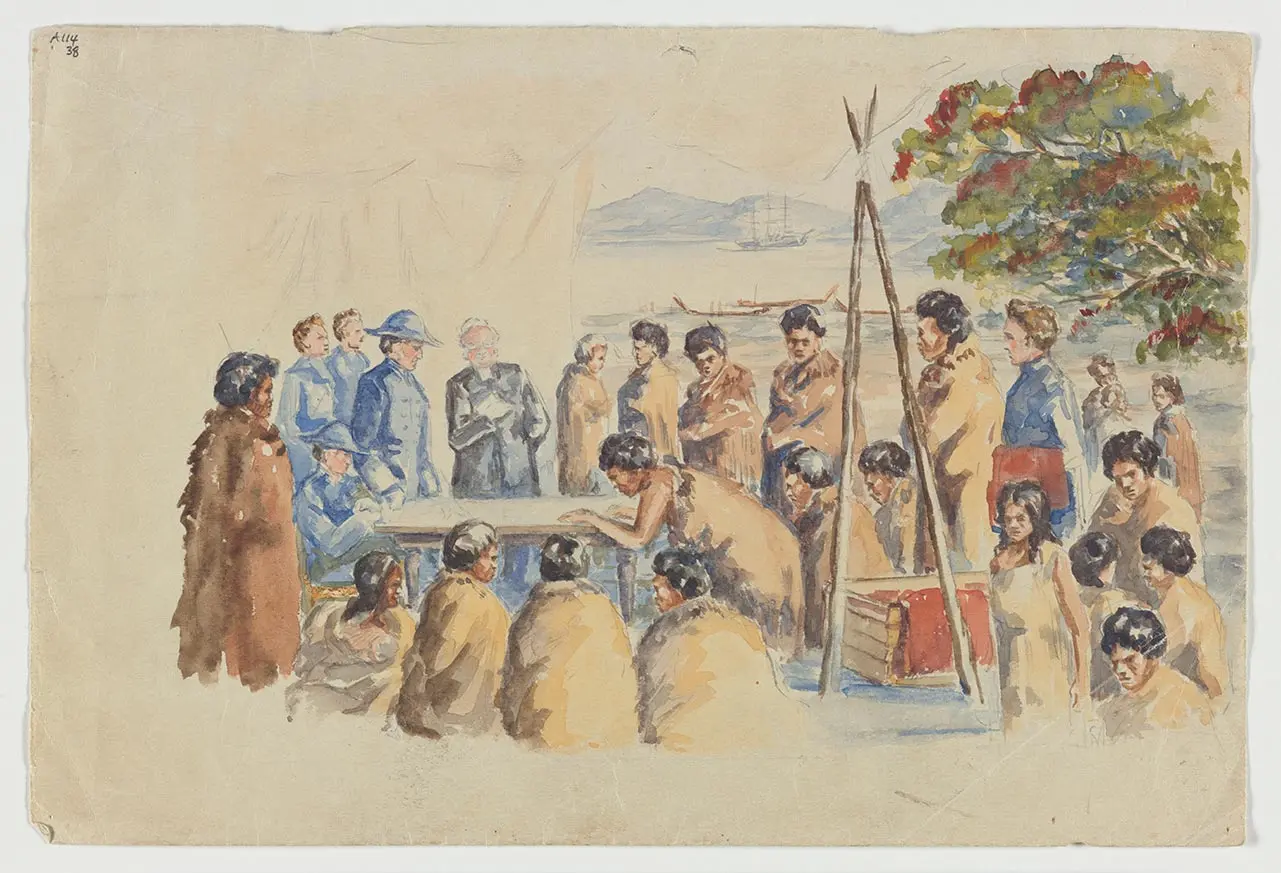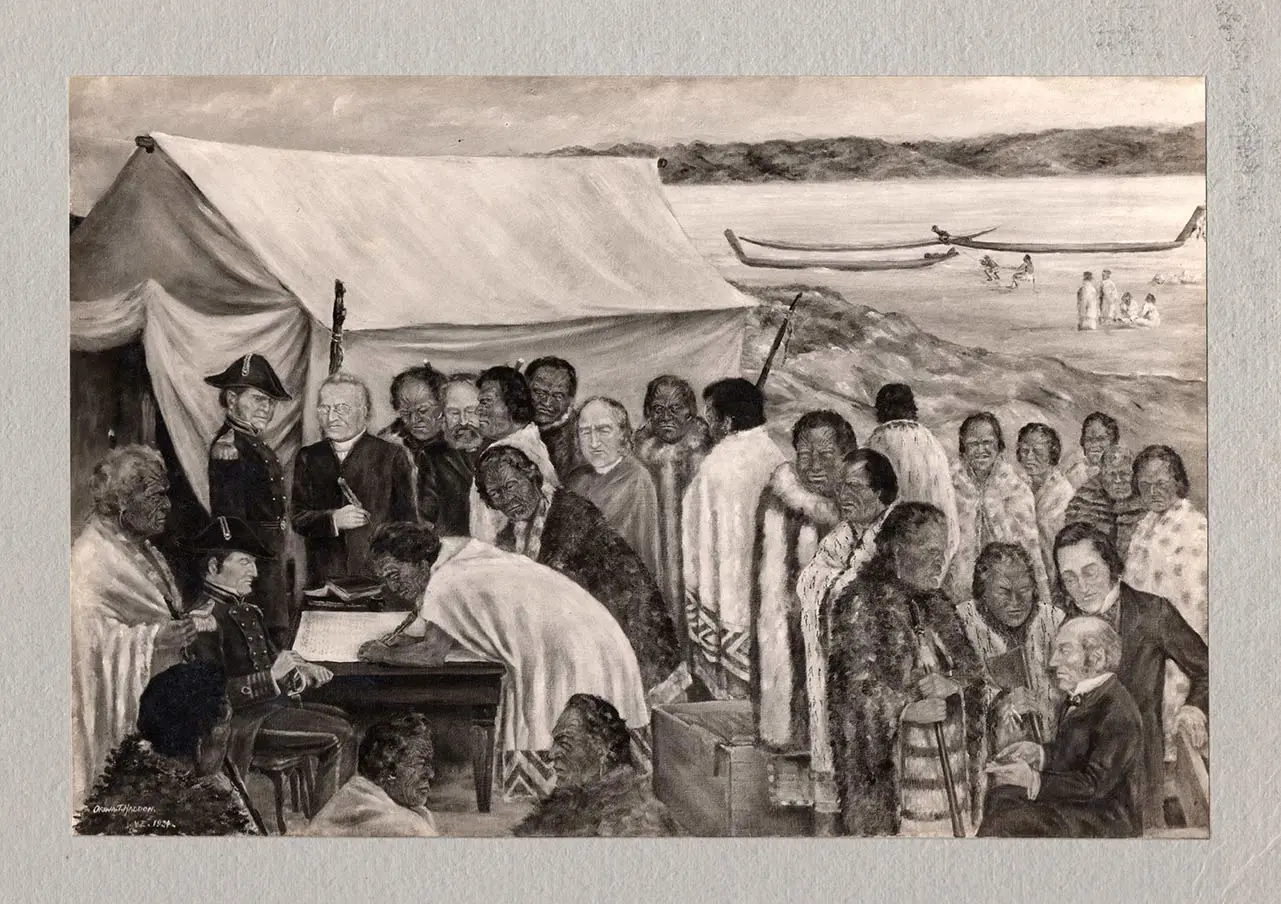Image credit: Reconstruction of the Signing of the Treaty of Waitangi, ca 1940 or 1930s attributed to Oriwa Tahupōtiki Haddon. Ref: A-114-038 Alexander Turnbull Library.

Image credit: Reconstruction of the Signing of the Treaty of Waitangi, ca 1940 or 1930s attributed to Oriwa Tahupōtiki Haddon. Ref: A-114-038 Alexander Turnbull Library.

This painting, thought to be by Oriwa Haddon, shows more Māori attending the Treaty signing than Europeans. Read about Haddon’s paintings and what else they show. Find out more by exploring our collections and curated resources.
In 1960, the Department of Māori Affairs donated a watercolour of the signing of the Treaty of Waitangi to the Turnbull Library. No details were provided about the artist, but it is thought to be Oriwa Haddon (Ngāti Ruanui; 1898–1958). A polymath, Haddon trained as a Methodist minister and pharmacist, but also gained a reputation as an artist and cartoonist and as a broadcaster. In 1934, his oil painting of the same scene was presented to the Governor General, Lord Bledisloe, and was hung in the Treaty House at Waitangi. This painting subsequently went missing, but was recorded in a photograph taken for a patent application. The similarities between the lost painting and this watercolour led Turnbull staff to attribute it to Haddon.
Both paintings are interesting for the prominence they give to Māori compared with the European figures, and they stand in marked contrast to the better-known painting of the Treaty signing by Marcus King, completed in 1938. In King’s reconstruction, Europeans outnumber Māori, a visual premonition of the influx of settlers to New Zealand after the Treaty was signed. The Māori depicted are also physically placed lower than the Europeans, who sit on a stage, making the former seem supplicant and submissive.
In Haddon’s works, in contrast, Māori (women as well as men) dominate among the figures grouped around the wooden table. In the watercolour, a man is signing the Treaty, watched by Lieutenant-Governor William Hobson, another naval officer and the missionary Henry Williams, who is translating. Other Māori, standing and squatting, also look on. The blue-robed man at the right may be the Catholic bishop Jean-Baptiste Pompallier, who argued for the Treaty to include a clause recognising different faiths. Pompallier is more obvious in Haddon’s oil painting (behind the men signing). Also depicted are the former British Resident James Busby (right foreground) and a bearded man (by the tent), who may be the Anglican missionary William Colenso. Colenso printed the Treaty and in 1890 published his own memories of the signing, The Authentic and Genuine History of the Signing of the Treaty of Waitangi.
Despite lacking the polish and official imprimatur of the King painting, these works by a largely unsung Māori artist may be a more accurate view of the Waitangi signing. They also reflect the Māori agency and engagement evident in Colenso’s account, which is regarded as the best eyewitness record of the event. Haddon died at Taihape on 17 June 1958, following a car accident.
Story written by: Paul Diamond
Copyright: Turnbull Endowment Trust
Photograph of original oil painting submitted to New Zealand Patent Office, 1934.
Image credit: The Signing of the Treaty of Waitangi by Oriwa Tahupōtiki Haddon. Archives New Zealand on Flickr. Some rights reserved: CC BY 2.0.

Image credit: The Signing of the Treaty of Waitangi, February 6th, 1840, 1938 by Marcus King. Ref: G-821-2 Alexander Turnbull Library.

Read a connected story from Te Kupenga: Signing the Treaty.
Explore the Alexander Turnbull Library collections further:
Topic Explorer has:
Many Answers has Treaty of Waitangi.
Want to share, print or reuse one of our images? Read the guidelines for reusing Alexander Turnbull Library images.
Tikanga ā-iwi:
Te whakaritenga pāpori me te ahurea
Te ao hurihuri.
Te Takanga o Te Wā (ngā hītori o Aotearoa):
Whakapapa
Mana motuhake.
Social sciences concepts:
Identity, culture, and organisation
Continuity and change.
Aotearoa New Zealand’s histories:
Māori history is continuous
Colonisation and its consequences
The exercise of power
Relationships and connections between people.